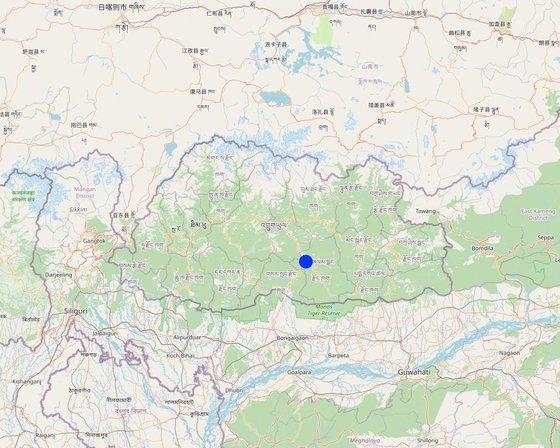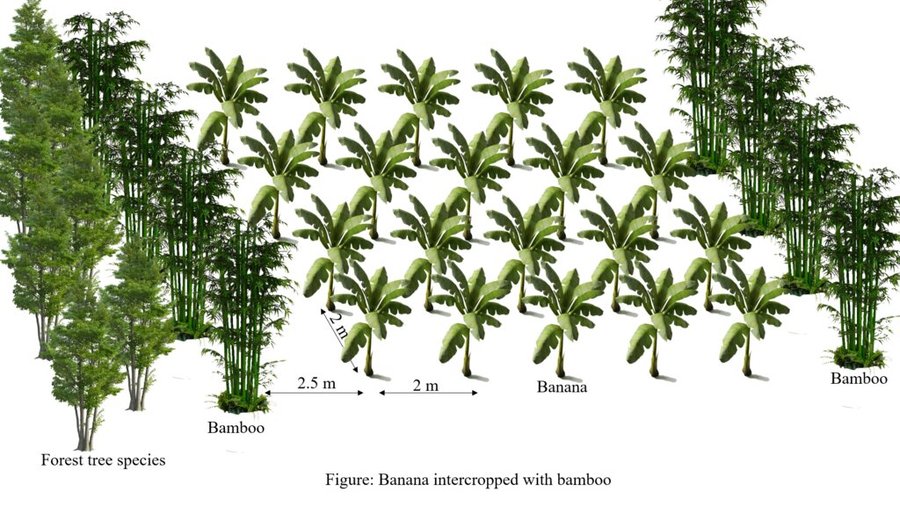



Fallow land is the term for arable fields either partially or completely left unused and unproductive, owing to reasons such as labour shortages, lack of irrigation, human-wildlife conflict and/or the plots being far away from the settlements. Land rehabilitation is a promising approach towards mitigating the fallow land issue. Thus, the Khengrig Namsum Cooperative (KNC), a registered firm under the Department of Agriculture Marketing and Cooperatives, Ministry of Agriculture and Livestock (MoAL), Bhutan has ventured into rehabilitating 235 acres (94 ha) of fallow lands since 2016, through the adoption of agroforestry. The KNC was founded by Mr. Thinley Wangdi (the current chairman), with the motive of improving the livelihoods of the people of Zhemgang Dzongkhag through locally grown farm produce.
The KNC with funds from the Global Environment Facility - Small Grant Program (GEF–SGP) through the United Nations Development Program (UNDP), Bhutan, revived the fallow through agroforestry (intercropping of banana and bamboo plants). The KNC intervened in three strategic locations, benefitting 36 households. This particular agroforestry approach was not only aimed towards enhancing livelihoods but also to diversify production: through banana chips production and bamboo product development.
Upon securing the funds, implementation started with the procurement of planting and fencing materials, hands-on training, and then planting and fencing activities. Installation of electric fencing was done to reduce human-wildlife conflict. There was specific training on product development. Moreover, the KNC was able to link up with nearby schools for the school feeding programme, to supply fruits and vegetables. The cooperative demonstrates skills in processing its own products and enabling better access to renewable natural resources in the locality. On the contrary, not having proper cold storage facilities has negative impacts on processing units and has resulted in unreliable market coupling.

สถานที่: Rebati Chiwog under Ngangla Gewog, Brumbi and Jiwongolia Chiwog under Trong Gewog, Zhemgang Dzongkhag, ภูฏาน
ตำนวนการวิเคราะห์เทคโนโลยี: 2-10 แห่ง
การเผยแพร่ของเทคโนโลยี: กระจายไปอย่างสม่ำเสมอในพื้นที่ (0.95 km²)
In a permanently protected area?: ไม่ใช่
วันที่ในการดำเนินการ: 2015
ประเภทของการแนะนำ








| ปัจจัยนำเข้า | หน่วย | ปริมาณ | ค่าใช้จ่ายต่อหน่วย (Ngultrum (Nu.)) | ค่าใช้จ่ายทั้งหมดต่อปัจจัยนำเข้า (Ngultrum (Nu.)) | %ของค่าใช้จ่ายที่ก่อให้เกิดขึ้นโดยผู้ใช้ที่ดิน |
| แรงงาน | |||||
| Labor | person days | 1440.0 | 451.0 | 649440.0 | 100.0 |
| อุปกรณ์ | |||||
| Land preparation | Lumpsum | 1.0 | 725432.0 | 725432.0 | |
| วัสดุด้านพืช | |||||
| Cost of seedlings (local banana and bamboo) | Lumpsum | 1.0 | 979170.0 | 979170.0 | |
| วัสดุสำหรับก่อสร้าง | |||||
| Electric fencing | Lumpsum | 1.0 | 267410.0 | 267410.0 | |
| Plantation of bamboo and banana | Lumpsum | 1.0 | 231594.0 | 231594.0 | |
| อื่น ๆ | |||||
| Project administration and participation | Lumpsum | 1.0 | 182042.0 | 182042.0 | |
| Project signboard and installation | Lumpsum | 1.0 | 19500.0 | 19500.0 | |
| Formulation of by-laws and agreements | Lumpsum | 1.0 | 72301.0 | 72301.0 | |
| Hands-on-training on plantations and product development | Lumpsum | 1.0 | 100781.0 | 100781.0 | |
| ค่าใช้จ่ายทั้งหมดของการจัดตั้งเทคโนโลยี | 3'227'670.0 | ||||
| Total costs for establishment of the Technology in USD | 40'345.88 | ||||
Crop production increased exponentially in Rebati, where crop production prevailed before the introduction of the agroforestry system. For the reverted fallow land in Brumbi and Jiwongolia, crop production increased by 100%. The abundant availability of bananas from the rehabilitated areas has greatly facilitated the cooperative employees in procuring a sufficient quantity of bananas for banana chip production. Previously, they had to embark on time-consuming journeys to various locations to source bananas, which not only proved laborious but also led to an increase in production costs.
จำนวนก่อน SLM: Local varieties
หลังจาก SLM: Improved varieties
The cultivation of enhanced banana varieties, including G9, Jaji, and Dosari, has resulted in a noticeable enhancement in quality
Following the harvest of banana fruit, the stems and leaves are utilized as fodder for livestock
The risk of production failure is minimized as the land users engage in agroforestry, diversifying their income sources. Their earnings do not rely solely on one crop; instead, they come from a variety of sources, including bamboo products, bananas, vegetables, and spices. Consequently, if one crop encounters difficulties or fails, the other crops can continue to generate income for the cooperative
Agroforestry promotes the diverse cultivation of both forest and agricultural plants, resulting in a wide range of products. As an example, the land users are able to produce bamboo products, spices, and banana chips due to the diversity of their cultivation practices
The technology is implemented in the previously uncultivated land (fallow) leading to the increased production area.
The conversion of fallow land into cultivated land has enhanced land management and stewardship. This transformation involves the addition of manure and timely interventions, effectively reducing soil erosion and improving the overall care of the land
There are increased expenses on agricultural inputs. However, the increased expenses are compensated by the income generated from the farm.
จำนวนก่อน SLM: Nu. 23,00,000/- annual income
หลังจาก SLM: Nu. 55,00,000/- annual income
The ready availability of bananas as a raw material has significantly boosted the production of banana chips and led to a substantial increase in the annual revenue of the cooperative. Furthermore, land users supplying bananas to the cooperatives have also experienced a rise in their annual income
The KNC has diverse value-added products and natural products such as watermelon, bamboo products, and homemade pickles diversifying their income sources.
Reduced workload due to increased availability of raw materials for banana chip processing.
The staff of the KNC is food secure due to increased income generated from the cooperative. Likewise, the land users supplying raw materials are also meeting the food security from the income generated by supplying raw materials to the KNC. The land users are self-sufficient in bananas, bamboo and some spices.
The land users shared that the improved annual income is directly related to improved health and well-being of the family/community.
Their venture into such activity has added value to the community, where the community has been recognized as one of the successful pilot sites for rehabilitating fallow lands. Moreover, external visitors are attracted to witness the success of the community.
Also, the community bond has been strengthened, through an approach like labour sharing practised during the implementation of the technology.
Before, the land users' knowledge about SLM technologies was confined to a few technologies. Now they have realized that SLM is a holistic approach involving different technologies. Therefore, the understanding and knowledge of agroforestry as one of the SLM measures has been enhanced.
Disadvantaged families constrained by poor market access benefited from this technology.
The plantation of banana plants and bamboo has covered a wide range of land, leading to better vegetation cover.
The increased vegetation cover by different fruit, bamboo, and vegetables leads to increased above-ground biomass.
Agroforestry harbours various plant species attracting diverse beneficial insects that feed on these plants.
The destruction of natural habitats has been decreased due reduced dependency of land users on wild bamboo products.
The risk of surface erosion has been mitigated due to improved ground cover.
Cultivation of bamboo species reduces wind velocity reducing surface erosion.
Biological diversity increased due to the cultivation of different plant species which also act as a habitat for different insects and birds.